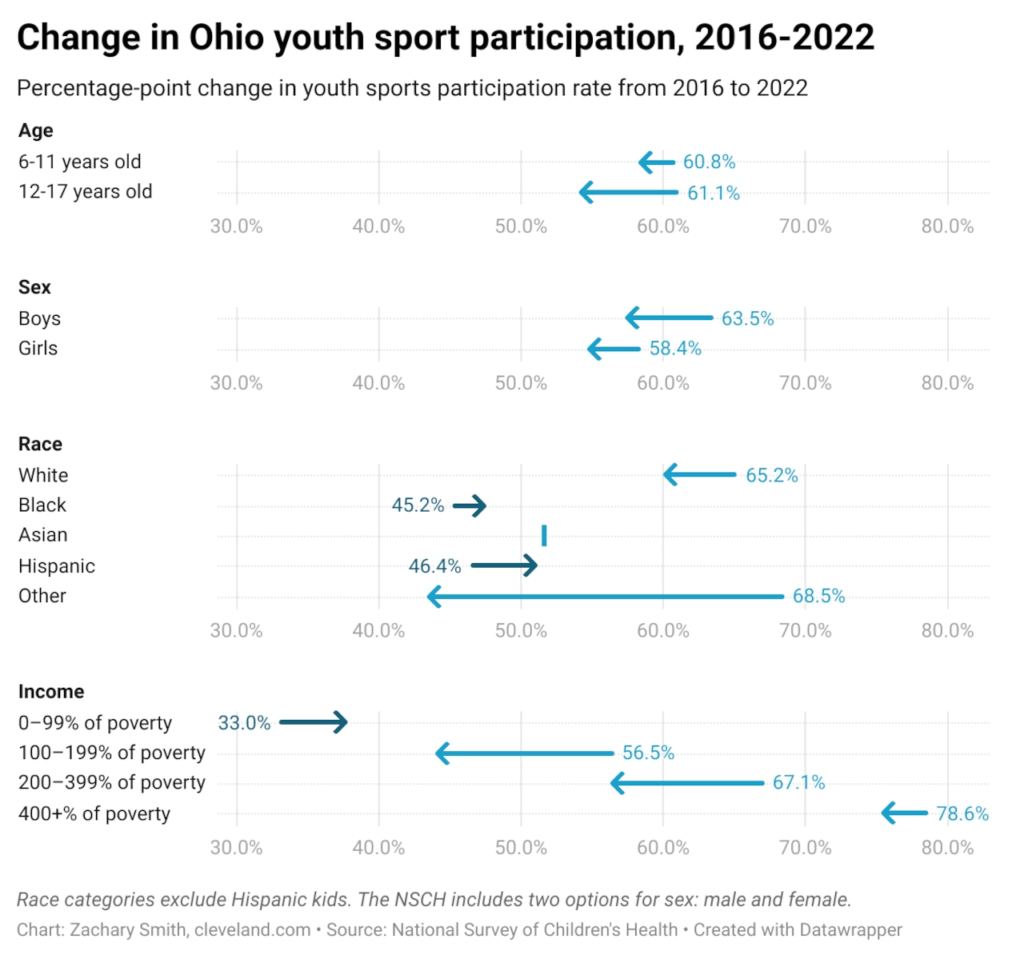CLEVELAND, Ohio — The percentage of children in Ohio who play after-school and weekend sports decreased by 4.7 percentage points from 2016 to 2022, according to data from the National Child Health Survey.
in Ohio from 2016 to 2017. 61% of children between the ages of 6 and 17 participated in a sports team or took sports lessons after school or on weekends. By 2021-22, this figure had fallen to 56.3%.
In Ohio, the percentage of children playing sports outside of school is still higher than the national average of 51.1%. Additionally, Ohio's loss is not as large as the overall decline in youth sports participation in the United States (7.3%).
Nationally, Minnesota and Vermont had the highest percentage of children playing sports in 2021-22, at 64.6%. New Mexico had the lowest rate at 39.8%.Sports participation rates tend to be higher in the northern United States
According to the Department of Health and Human Services, playing sports can improve children's physical and mental health.
This includes improving bone health, cardiovascular fitness, muscle health, and reducing the risk of depression. Sports can also help develop confidence, self-esteem, and social and interpersonal skills.
However, multiple barriers prevent children from playing sports, according to HHS. These include increased fees and facility costs, lack of access to facilities and programs, and time constraints, which disproportionately impact low-income households.
In 2021-2022, 37.6% of Ohio children living below the federal poverty line played sports, compared to 44.1% of children with household incomes between 1 and 2 times the federal poverty line. was. Three out of four children in families above 400% of the poverty line played youth sports.
However, the only income group that saw an increase in participation in Ohio was students below the poverty line, whose percentage rose from 33% to 37.6%. The steepest decline was among people with household incomes between one and two times the federal poverty level, falling from 56.5% to 44.1%.
Youth sports demographics
Ohio's older children, ages 12 to 17, saw a steep decline in sports participation compared to younger adults, dropping 6.9 percentage points from 61.1% to 54.2%. On the other hand, the number of respondents aged 6 to 11 decreased by only 2.4 points, from 60.8% to 58.4%. This also means that younger children are more likely to play sports than older children.
The same is true for the country as a whole, but the losses are even greater. Among children aged 12 to 17, the percentage decreased by 8.2 points from 59.1% to 50.9%. On the other hand, the number of respondents aged 6 to 11 decreased by 6.2 points from 57.6% to 51.4%.
From a gender perspective, men's participation in youth sports has declined more rapidly than women's. In 2016-17, 63.5% of male students participated in sports after school or on weekends, but this decreased by 5.8% to 57.7% in 2021-22. The female participation rate decreased by only 3.2 percentage points, from 58.4% to 54.8%.
Nationally, the story is reversed. The participation rate of male students in youth sports decreased by 6.9 points to 54.4%, while the participation rate of female students decreased by 7.4 points to 47.8%.
White students were the only ethnic group in Ohio whose participation rate decreased from 65.2% to 60.1%. Hispanic participation increased by 4.6 percentage points and black participation increased by 2.2 percentage points.
In the original 2016-2017 survey for Ohio State, students of Asian descent were initially not tracked and classified as “other non-Hispanic.” However, in 2021-22, 51.6% of Asian students will participate in youth sports, with 43.6% choosing “other.”
Nationally, youth sports participation rates have declined across all ethnicities, with the steepest decline among Asian students, falling from 55.6% to 45.2%. Black and Hispanic students had the lowest participation rate at 41%.
Zachary Smith is our next data reporter. cleveland.com.you can contact him zsmith@cleveland.com.


